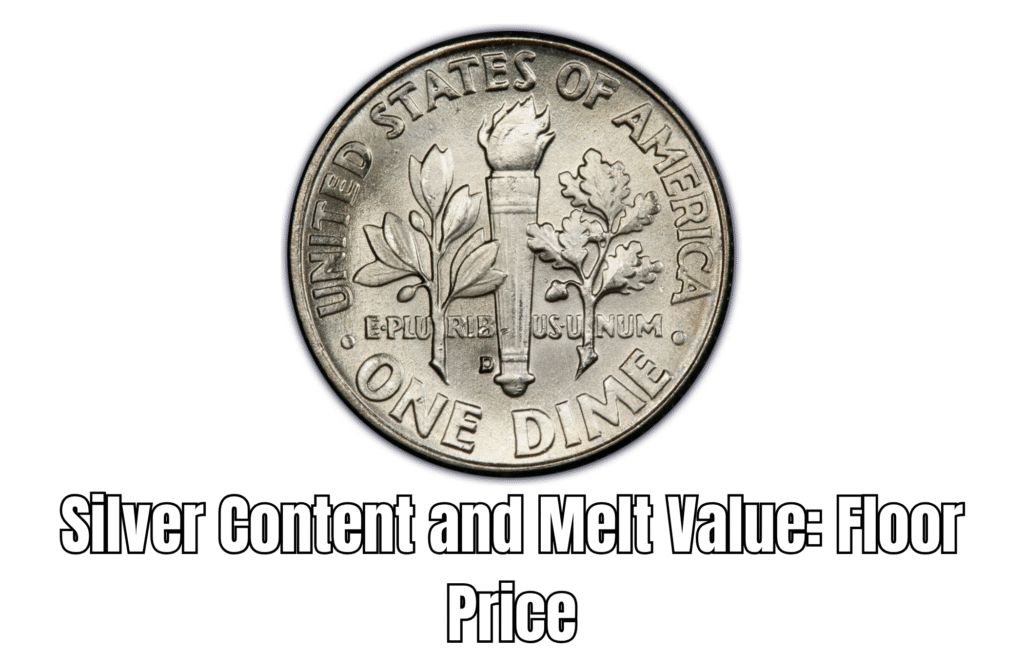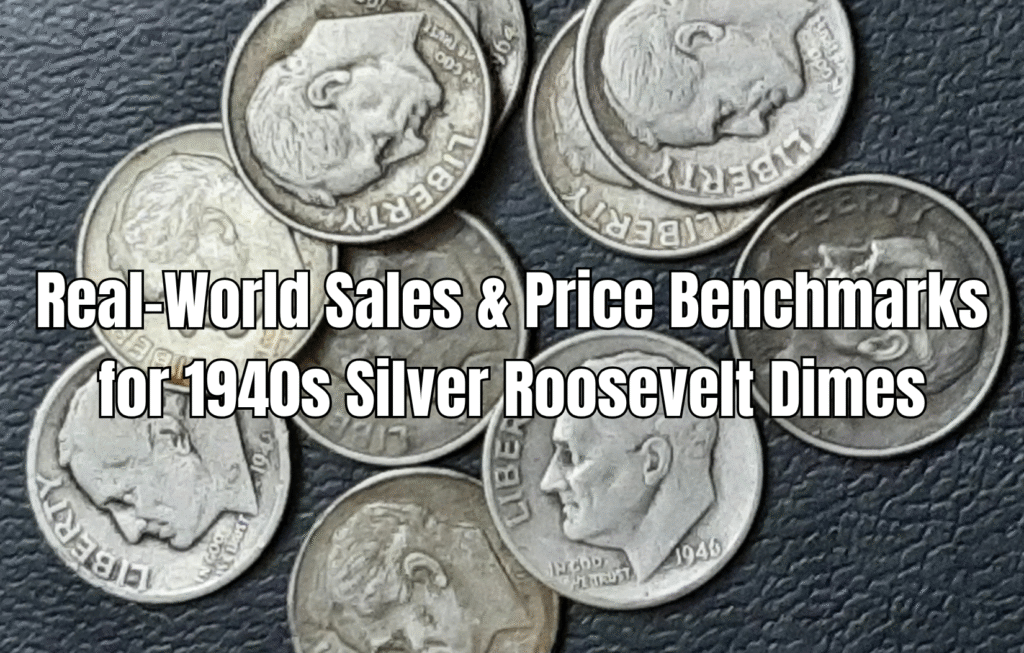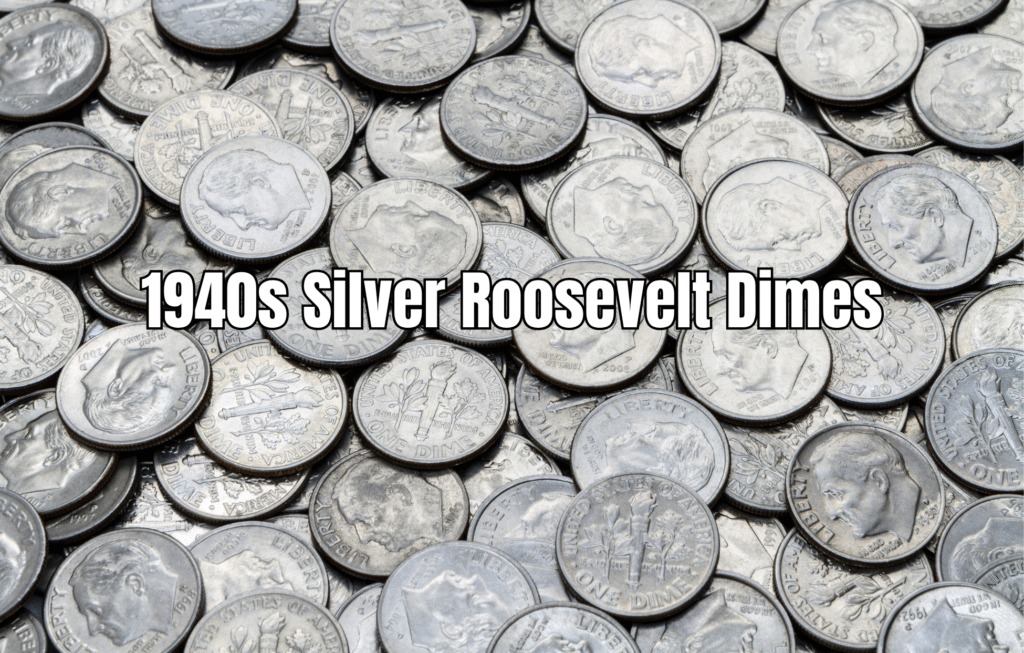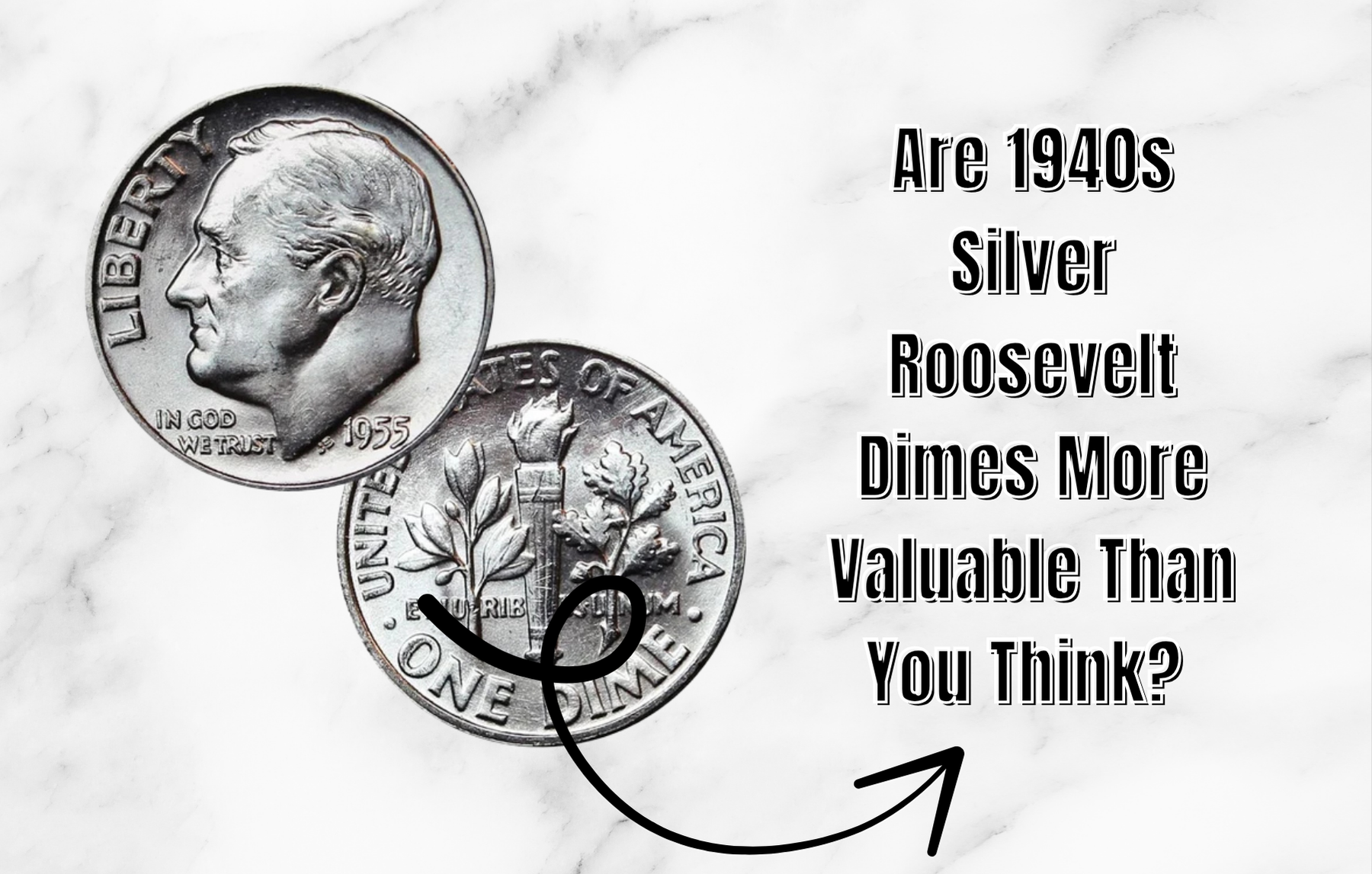Introduction: The Roosevelt Dime and Its Silver Era
The Roosevelt dime was introduced in 1946 to honor President Franklin D. Roosevelt shortly after his passing in 1945. The design replaced the Mercury (Winged Liberty) dime and was minted as a silver dime (90% silver, 10% copper) from 1946 through 1964.
Because of its silver content and collectible demand, Roosevelt dimes minted during the 1940s (especially late 1940s) hold a special place among silver coin collectors. Many of them are worth significantly more than face value or melt value, especially in higher grades or with special features (e.g. “Full Torch Bands,” low mintage, or certified mint state pieces).
Below, we explore why 1940s silver Roosevelt dimes are more valuable than many people assume.
1. Silver Content and Melt Value: Floor Price

Every Roosevelt dime minted between 1946 and 1964 contains 0.07234 troy ounces of silver (90% silver, 10% copper) in a total weight of approximately 2.50 grams.
That means, regardless of date or condition, each silver Roosevelt dime has an intrinsic value tied to the current spot price of silver. For instance:
- As of recent data, silver spot is about $32 – $37 per ounce (depending on market fluctuations).
- Multiplying by the 0.07234 oz silver content, the melt value of such a dime is typically in the range of $2.30 to $2.70+, depending on the silver price.
- Melt value acts as a floor—you would not expect a common 1940s Roosevelt dime in poor condition to sell for less than its silver content (unless severely damaged or cleaned heavily).
2. Numismatic Premiums Over Silver: What Drives Extra Value
While the melt value ensures a base worth, many 1940s Roosevelt dimes command numismatic premiums above that baseline. The factors that push their value higher include:
A. Condition / Grade
- Coins in uncirculated (Mint State, MS) grades, especially those with strong lustre and minimal contact marks, attract premiums many times over the melt value.
- Graded coins encapsulated by reputable services tend to fetch better prices.
B. “Full Bands” or “Full Torch Bands” Variety
- Some Roosevelt dimes (especially in later years) show complete and strong horizontal bands on the torch (on the reverse). Collectors often award a “Full Bands” (FB) or “Full Torch Bands (FTB)” designation, which commands extra premium.
- While this is more commonly discussed for post-1940s Roosevelt dimes, condition and strike quality can also affect desirability for earlier ones in the 1940s.
C. Rarity / Low Mintage Issues
- Some years and mintmarks had lower mintages, making them less common in high grades.
- In particular, the 1949-S Roosevelt dime is often highlighted as a key collectible because it had a relatively low mintage (about 13,510,000) compared to other years in that era.
- Because fewer examples got examined, preserved, or saved in pristine condition, high-grade examples of those lower-mintage dates often command significant premiums.
D. Demand, Set Completion, & Collector Appeal
- Many coin collectors build Roosevelt dime sets, especially focusing on the silver (1946–1964) run. The competition to complete sets pushes demand for clean, high-grade examples.
- Legendary or high-grade specimens serve as “flagship” pieces in collections, adding prestige value.
E. Historic & Aesthetic Appeal
- The transition era just after WWII, and the association with Roosevelt and the March of Dimes charity, adds narrative appeal.
- Coins with attractive toning, original luster, or minimal wear are more eye-catching to collectors.
3. Real-World Sales & Price Benchmarks for 1940s Silver Roosevelt Dimes

Here are examples and benchmarks that show how high-quality 1940s silver Roosevelt dimes have sold or are priced in 2025:
- Price guides list values across grades from MS 40 up through MS 69.
- One specific example: the 1949‑S Roosevelt dime is considered a semi-key date. In circulated condition (XF40), it may fetch roughly twice what many other silver Roosevelt dimes in similar condition command. In MS 65, it has sold for tens of dollars or more.
- Auction sales: an MS 67 specimen of 1949-S with Full Bands reportedly sold for about $3,720 in 2018.
- In general, common 1940s Roosevelt dimes in mint state grades might range from $10 to $50+, depending on strike and eye appeal.
- Price guide tables show values rising steeply for MS63, MS64, MS65 grades in many 1940s dates.
These real-world data points confirm that condition and rarity really drive premiums above the silver baseline.
4. How to Identify & Evaluate a 1940s Silver Roosevelt Dime
If you believe you have a 1940s silver Roosevelt dime, here are practical steps and tips to assess its potential value:
Step 1: Verify the Date and Mintmark
- Confirm that the coin date falls between 1946 and 1949 (or any 1940s Roosevelt). Though the Roosevelt dime wasn’t minted prior to 1946, so “1940s” effectively means 1946–1949 for Roosevelt types.
- Check for mintmarks: “D” (Denver) or “S” (San Francisco). Some key value differences come with mint locations, especially San Francisco in 1949.
Step 2: Check for Silver Content & Composition
- The coin should be 90% silver, 10% copper.
- Check weight (~2.50 grams) and diameter (17.91 mm) to see if it matches standard silver Roosevelt dime specs.
- If it’s “clad” or newer (post‑1964), it won’t have silver content.
Step 3: Examine Overall Condition / Surface Quality
- Look for minimal wear on high points (e.g. Roosevelt’s hair, cheek, ear) and good surface strike.
- Avoid coins with heavy scratches, corrosion, cleaning damage, or harsh toning.
Step 4: Look for Full Bands / Full Torch Detail (if applicable)
- On the reverse, inspect the torch and the horizontal bands for completeness and sharpness.
- A coin with strong, well-defined bands or original sharpness will tend to command a premium.
Step 5: Use Magnification & Compare to Reference Images
- Use a loupe (10×) or microscope to inspect fine details, edges, strike quality, and die flaws.
- Compare with high-resolution images of known high-grade or certified specimens to spot subtle features.
Step 6: Consider Certification & Grading
- Submit if you believe the coin is in particularly high grade (MS63+) or is a rare mintmark or date.
- Grading by reputable services adds credibility, helps protect the coin, and typically increases the sale value.
Step 7: Check Auction Archives & Price Guides
- Review historical auction results or dealer listings for similar dates, grades, and mintmarks.
- Use resources like price guides or dealer catalogs to benchmark.
5. What May Cap Value & Risks to Be Aware Of
While many silver Roosevelt dimes can be valuable, there are limitations and risks to be aware of:
- Market volatility in silver: A big drop in silver spot price can lower the floor (melt value) and affect demand.
- Overgraded or overhyped coins: Sellers may exaggerate condition or demand a premium beyond what the market will realistically bear.
- Damage, cleaning, and alteration: Even a rare date loses value if the surface is damaged or has been cleaned aggressively.
- Low-population grades: Some coins exist in very few high-grade examples; even if “rare,” if no buyers exist at that price point, value may be stagnant.
- Certification fees vs. expected return: For moderately valuable coins, the cost of grading might exceed the premium gained.
6. Why 1940s Silver Roosevelt Dimes Are Underappreciated

There are a few reasons why these dimes might not be as valued as they deserve:
- Common dates overshadow rarer ones: Many Roosevelt dimes from 1946–49 had very high mintages. Those common-date, low-grade examples are mostly judged by melt value, which can cause many to overlook the potential in better ones.
- Collector focus often on post‑silver coins or error types: Many casual collectors stop at clad-era coins, or focus on error coins, missing these silver issues.
- Lack of awareness of key years: People may not know that the 1949-S is a semi-key date, for example, and undervalue “ordinary-looking” silver Roosevelt dimes.
- Basement mentality: Because silver coins were once common, some dismiss older dimes as “just silver” without checking condition or mintmark closely.
7. Summary: The Bottom Line
- Roosevelt dimes minted during the 1940s (i.e. 1946–1949) are silver dimes (90% silver) and thus always carry intrinsic metal value.
- Above that, they can command substantial numismatic premiums if in high grade, strong strike, or rare mintmark (especially 1949-S).
- Real-world sales show that top specimens have sold for thousands of dollars, particularly in pristine, certified condition.
- If you find or own one, take care to verify date, mintmark, condition, and consider grading—doing so could unearth a hidden gem.
FAQs
1. What are 1940s Roosevelt dimes made of?
They’re composed of 90% silver and 10% copper, weighing about 2.5 grams. All Roosevelt dimes from 1946 to 1964 were struck with this silver alloy.
Why are silver Roosevelt dimes more valuable than face value?
Their intrinsic silver content gives them melt value, often over $2.50. Additionally, condition, rarity, and collector demand can raise values far beyond silver weight alone.
What’s the melt value of a silver Roosevelt dime?
Based on 0.07234 oz of silver, their melt value ranges from around $2.30 to $2.70+, depending on current silver spot prices.
